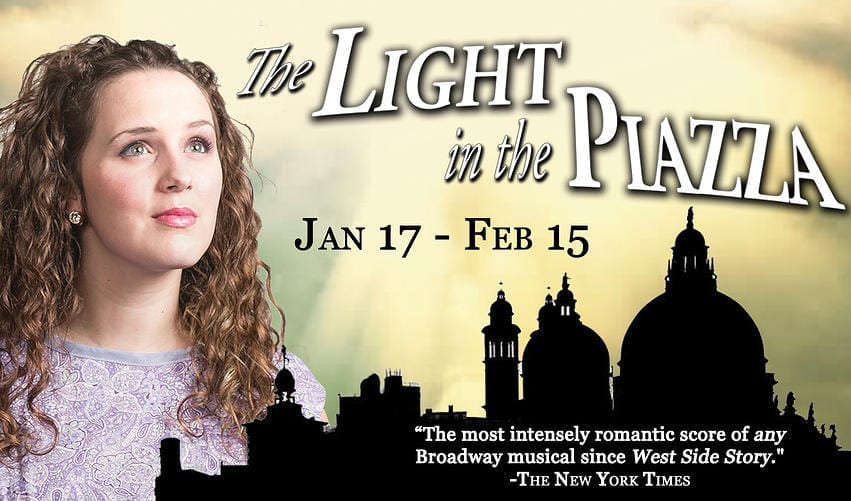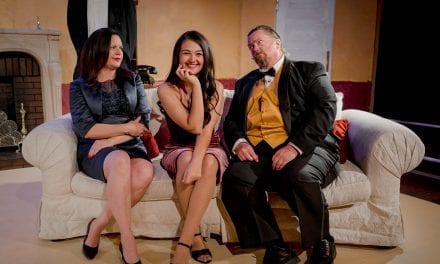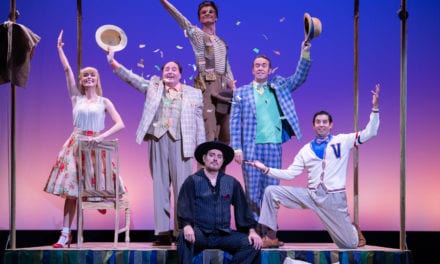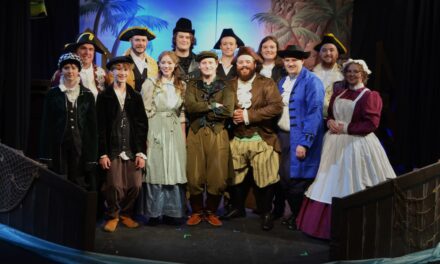OGDEN — Before the start of the Ziegfeld theater’s Light in the Piazza, the artistic director came on stage and talked a little bit about their mission, which is to raise the bar of community theater quality. While I can’t say that the bar has necessarily needed to be raised (Utah produces some excellent community theater), the Ziegfeld’s Light in the Piazza does not disappoint.
The award-winning 2005 musical is, in many ways, a nostalgic romance reminiscent of the golden age of cinema. The show opens on Margaret and Clara, a mother daughter team vacationing in sunlit Florence. They are both in love—with the culture, with the art—when a mischievous gust of wind sweeps Clara’s hat right off her head and into the hands of a dreamy Italian, Fabrizio. Clara is smitten. Margaret is determined. Under no circumstances will her daughter be allowed an Italian lover.
But Fabrizio is not deterred. Using information from a friend who works at the women’s hotel, he follows the pair to every tourist stop in an effort to gain a few more minutes in her company. Obstacles are gradually overcome as Fabrizio enlists the aid of his father and family to win over the stoic Margaret. As the relationship develops and Fabrizio and Clara fall deeper in love, it becomes apparent that Margaret knows more than she’s telling, and that her fear of a long-term romance is based on more than the usual motherly worry.
Perhaps the strongest element of the show is Adam Guettel’s sweeping score, and music director Rick Rea has made the most of it by assembling an excellent 6-piece ensemble. The live strings added a needed lushness to the score, and allowed the actors liberty to interpret the music in the moment.
 On the subject of actors, director Morgan Parry has assembled a strong cast. Lindsea Garside shines as Clara, bringing her to life with the right mixture of sweetness and child-like stubbornness. Her rendition of “Light in the Piazza” was touching yet believable, and her angry outburst in “Clara’s Interlude” was one of the better moments of the night. Scott Stuart makes a charming Fabrizio, with a voice that soars on ballads like “Love to Me.” Fabrizio has a difficult vocal part, and Stuart occasionally struggled to maintain his character on difficult passages in songs like “Il Mundo Era Vuoto,” but his energy and vocal power easily compensated for any deficiencies.
On the subject of actors, director Morgan Parry has assembled a strong cast. Lindsea Garside shines as Clara, bringing her to life with the right mixture of sweetness and child-like stubbornness. Her rendition of “Light in the Piazza” was touching yet believable, and her angry outburst in “Clara’s Interlude” was one of the better moments of the night. Scott Stuart makes a charming Fabrizio, with a voice that soars on ballads like “Love to Me.” Fabrizio has a difficult vocal part, and Stuart occasionally struggled to maintain his character on difficult passages in songs like “Il Mundo Era Vuoto,” but his energy and vocal power easily compensated for any deficiencies.
In the supporting cast, David Knowles’s portrayal of Fabrizio’s philandering brother Giuseppe was a standout. While Craig Lucas‘s script has Giuseppe speaking Italian most of the time, the meaning was never lost. In one scene he and his father (Caleb Parry) tease Fabrizio about Clara, and in spite of the language barrier, it was a funny and well executed scene. As Giuseppe’s wife, Heidi Hunt effectively portrays the character’s jealous side, yet tempers it with some empathy and maternal instinct.
However, in spite of a strong supporting cast, the night belonged to Rachel Shull as Margaret Johnson. A grounded actress and an accomplished singer, Shull won my sympathy from the first to the last. Her witty asides to the audience never failed to solicit a laugh, and her understated interpretation of “Dividing Day” is thoroughly heartbreaking. As Clara and Fabrizio’s love begins, the audience watches her own marriage thoroughly unravel through a series of phone calls with her husband, played with a believable diffidence by Troy Hone. Shull carries the audience through a terrific character arc, from a closed realist to a cautious romantic.
The set, designed by Rick Rea, makes good use of a small space. While the whirling pillars occasionally distracted, they effectively communicated changes of location while creating a distinctly Italian setting. Parry uses the flexible set to her advantage with smart staging choices. The rapidly changing pillar formations create a real sense of urgency in Clara’s hysteria, and the set changes allowed the show to flow seamlessly from one scene to the next. Austin Stephenson’s lighting creates a romantic setting and appropriately enhances the action. The use of silhouettes in the song “Auitami” is visually striking and makes that song truly pop.
There are small critiques can be made. The ensemble often distracts with an acting style that is much more farcical and showy than the grounded realism employed by the principal characters. In one particular scene, an old woman walks across the stage wide eyed and deadpan, and while the moment solicited a laugh, it pulled focus from the more important development of Clara’s character. Alina Gatrelle’s generally consistent and lovely costumes were hindered by a few distracting pieces, and old age makeup is applied more effectively to some actors than others
But these specifics are more a question of budget than artistic talent, and the Ziegfeld’s production delivers in every area that counts. The effective direction, talented cast, and excellent orchestra make this an impressive community production. I was moved more than once, and if you have an appreciation for beautiful music, or simply want to be carried away by a love story set in the most romantic place on earth, get down to the Ziegfeld to see The Light in the Piazza.






